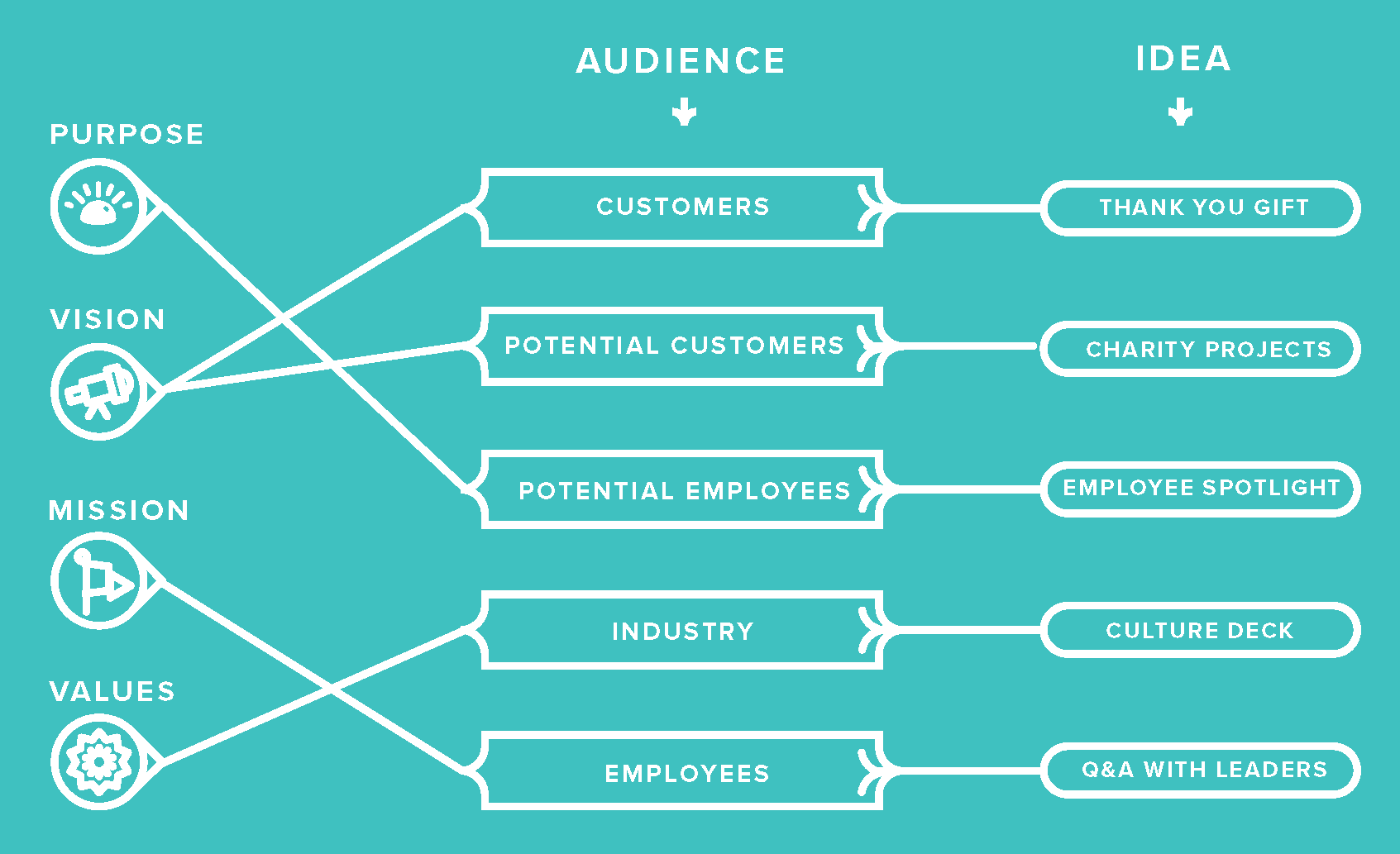Brands are not faceless corporations; they are living, breathing entities built by humans—real people who gather every day in pursuit of a particular goal, whether it’s baking the world’s best cookie or providing the best security software. But this human element is easily lost in marketing. Brand content is often generic and dry, lacking personality and a compelling story. People can’t connect to it, and therefore, it doesn’t do its job. Luckily, there is a unique type of content that can create powerful connections by showing people what your brand is like behind the scenes. It’s called culture marketing.
What Is Culture Marketing?
Culture marketing is a form of content marketing that showcases your culture to help people get to know your brand.
Whereas general content marketing may be focused on your service, product, industry, or area of expertise, culture marketing focuses on who you are, what you care about, and how you interact with the world.
By translating your company culture into compelling content, you can introduce people to the humans behind your brand and build a community of people who share your values. The more you create these types of meaningful relationships, the more you’ll be able to grow your brand.
Example: To give people a behind-the-scenes look at its company culture, Zappos created the Culture Book, an in-depth look at the people, values, and practices that make the company unique. This is a simple piece of content that offers a unique insight into why the brand is so special.
Why Should You Care About Culture Marketing?
People’s expectations of brands have changed drastically. It’s not just about what product or service your brand sells. People care about who you are, what you stand for, and how you treat others. They want to buy from, work for, and collaborate with brands who reflect their own beliefs and values.
[bctt tweet=”Culture marketing isn’t bragging about your greatness; it’s showcasing the things that make your brand truly unique. ” username=”columnfive”]
In a crowded world where industries are increasingly commodified, culture marketing is a huge competitive advantage and a powerful way to connect with the people your brand regularly interacts with—in all spheres.
- Existing customers: It’s always easier to retain existing customers than recruit new ones. Through culture marketing, you can engage your current customers at every stage of the buyer’s journey, including long after your sale is completed. For example, if you create content around your team’s volunteer efforts, people may support your brand by donating to your team’s cause. This creates a shared sense of purpose and cultivates a lasting relationship.
- Potential customers: Culture marketing helps people get to know who you are and what you stand for, which may be the extra nudge they need to make a buying decision. For example, an infographic detailing your team’s passion for eco-friendly causes can easily sway someone to go with you over your competitor.
- Partners: There are many people outside your immediate ecosystem who want to hire or partner with you (think vendors, non-profits, influencers, industry partners, sponsors, etc.). Culture marketing gives them insight into who you are so they can decide whether or not your values align.
- Current Employees: Employee satisfaction is crucial to growing a successful brand. Culture has a huge effect on their work life. Celebrating that culture through content helps employees feel more engaged, making them more invested in your brand’s success.
- Prospective Employees: Culture marketing is one of the best ways to find like-minded talent. Whether it’s your vision, work space, or team energy that draws them to you, telling this part of your brand story is a great way to attract the best and brightest—even when you can’t match your competitors’ salary or benefits.
⇒77% of adults would consider a company’s culture before applying for a job there.
—2019 Glassdoor Mission & Culture Survey
The more you can tell interesting stories about your brand, the more you can pique people’s interest and bring them into your brand story.
Example: Zendesk does a fantastic job of communicating their culture through unique content. This Women at Zendesk video gives prospective female employees a sense of how they may be supported if they come to work for the brand.
What Does Culture Marketing Look Like?
Culture marketing is just an extension of content marketing. Whether you’re publishing culture content through your blog, social platforms, or newsletter, there are plenty of formats and channels to tell your brand’s story. But some of the most common include:
- Article/blogs
- Data Visualization
- Motion Graphics
- Infographics
- Microcontent
- Photos
- E-books
- Videos
- Interactive Graphics
- Slideshows
[bctt tweet=”Good culture marketing is good storytelling. Tell the right stories, and you’ll attract the people who will become lifelong fans. ” username=”columnfive”]
What Makes Good Culture Marketing?
The key to successful culture marketing is finding the right stories. That means identifying things that are:
- Interesting: Most industries are becoming commoditized and more competitive, which makes it harder for brands to stand out. Good culture marketing will capture people’s attention and make them want to know more about you.
- Unique: One of the biggest advantages of your culture is that it’s entirely unique to you. Only you have your experience, your specific team, your vision. Highlighting these traits is the best way to create memorable content.
- Personable: Culture marketing is a powerful way to humanize your brand, so think about ways to tell people-centric stories that bring your brand to life.
The good news is these stories are everywhere; you just have to uncover them in your own organization.
Example: In the wake of the pandemic, as our team sheltered in place across the country, we created a shot-from-home video to offer solidarity and well wishes to our community. As “be good to each other” is one of our core values, the video was a simple way to use our culture to keep us connected.
How to Create Good Culture Marketing
Not sure where to start? Here’s a step-by-step to guide create awesome culture marketing that communicates your true identity.
[bctt tweet=”The things that make your culture unique are the stories you need to tell. ” username=”columnfive”]
STEP 1: Start with a Culture Checkup
Every brand’s culture develops over time. Whether you’re a 100-year-old brand or a fresh startup, your culture is reflected in everything you do, from how you talk to your team, to how you treat your partners, to how you ideate for new product ideas. That said, your culture ultimately stems from your Brand Heart, which includes your:
- Purpose: Why do you exist?
- Vision: What future do you want to help create?
- Mission: How do you create that future?
- Values: Who are you? How do you work?
These are your core beliefs, the elements that influence your actions, fuel your business, and shape your culture.
Having a clear understanding of your Brand Heart is crucial if you want to cultivate a culture that’s worth telling stories about. We hate to sound hack, but culture marketing is all about authenticity. You can’t fake a better culture, nor should you want to.
That’s why it’s important to start with a culture checkup wherein you articulate your Brand Heart. (This is especially important for older brands that have evolved since the CEO’s grandfather launched the business.)
HOW TO DO IT
You may already have a version of these elements articulated. If so, gather your brand team to assess if your Brand Heart is accurate and if it’s expressed appropriately. If you haven’t done this before (or want to refresh what you have), download our free Brand Heart workbook to identify your purpose, vision, mission, and values.

As you work through the process, evaluate each element individually. It’s important to have your identity written in the language you actually use. (Is your mission accurate but presented in dry, corporate-speak?) You should also aim to phrase everything in a few sentences. The more simple your Brand Heart is, the easier it is to remember. (If you’re struggling to do this, your Brand Heart is probably not as well-defined as it should be.)
Pro tip: It’s also helpful to display your Brand Heart as a reminder of why everyone in your company shows up to work each day.
STEP 2: Identify What Makes You Unique
Before you dive into brainstorming your next blog post, think about why your culture is special, why your company is a great place to work, what you might want to call out, etc. These unique traits are what you want to put front and center in your content. Whether you cover them directly or use them to brainstorm ideas, they’ll put you on the right path.
HOW TO DO IT
Think about the things that are most interesting about your brand. You can start by asking yourself:
- What do people enjoy most about your culture?
- What are a few words people might use to describe your culture?
- What are you “known” for (e.g, themed parties)?
- What are things you do that are unique to your company (e.g., scavenger hunt for new hires)?
- How do you show employees you appreciate them?
- What are the unique causes or initiatives you care about?
Example: While many companies provide on-site meals, TOMS hosts a particularly unique happy hour, pairing beer, wine, and Girl Scout cookies. (Yep, you read that right.)
STEP 3: Brainstorm Content Ideas
This is the fun part. The more you look for ideas, the more you’ll see them all around. But first you need to know what to look for. There are endless ways to do culture marketing, but if you’re just starting out, it helps to brainstorm ideas around specific themes (aka pillars).
HOW TO DO IT
During these first brainstorms, gather your creative team and anyone else who might have interesting insight. Choose some of the most unique traits about your company (say, 3-5), and use each trait as a pillar to ideate around. We recommend coming up with 10-20 ideas for each pillar.
As you get your creative juices flowing, you’ll likely come up with additional pillars or general content ideas. If you’re looking for more inspiration, you can also check out these 5 culture marketing story ideas and examples.
Example: As more teams go remote, brands are looking for creative ways to show appreciation. Dell cares for their team by sending care packages, as revealed in a fun shot-at-home unboxing video on their Instagram.
STEP 4: Map Your Ideas to the Right People
Culture marketing isn’t just about telling your stories; it’s about telling the right story to the right person. You have many different people you’re communicating with through content, from employees, to partners, to potential customers. Once you have your ideas, consider which idea would be most interesting or relevant to which group.
HOW TO DO IT
To vet your ideas, map each story idea to its intended audience. This will help you figure out whether your story will be interesting, what format it should take, what channel you should use to promote it, etc.
Your map may look something like this:

Marketing personas are especially helpful to vet your ideas. If you don’t have them, follow our guide to create them quickly and easily.
STEP 5: Empower Your Team to Create Content
The more you practice culture marketing, the more comfortable everyone will become with showcasing their behind-the-scenes world. Mobilizing your team to create that content is also a great way to make them feel included and engaged.
HOW TO DO IT
Welcome ideas through public channels, think of ways to highlight people’s work or skills, try these tips to turn your employees into content creators, and learn how to optimize your content creation process. You can also download our free e-book Culture Marketing: How to Turn Your Brand Heart Into Content.

Set Yourself Up for Success
Like any marketing effort, creating the right content requires the right people, the right infrastructure, and the right strategy. To make sure your content is a success…
- Use the right channels. You want your content to be seen, so check out our Ultimate Guide to Content Distribution e-book to identify the platforms your people are most likely to be.
- Identify your metrics. No matter what type of content you’re producing, there’s no point in putting in the work to create it if you can’t tell what’s working or not. Follow our guide to choose the right metrics to measure your success.
- Nurture your brand. It’s tough to do good culture marketing if you don’t have a culture worth showcasing. If you think your culture needs some rehab, follow our tips to create a strong brand culture, as well as our tips to build your remote culture if your team is working from home.
That said, we know that time and resources can be in short supply for content marketers. If you’re struggling to find the right stories or don’t have the bandwidth tell them well, we’d be happy to talk about how we can help.





I learned a lot thanks
Hope it helps!
Thank you for the information
Happy to help!
Well structured blog on Cultural marketing .
Thanks much